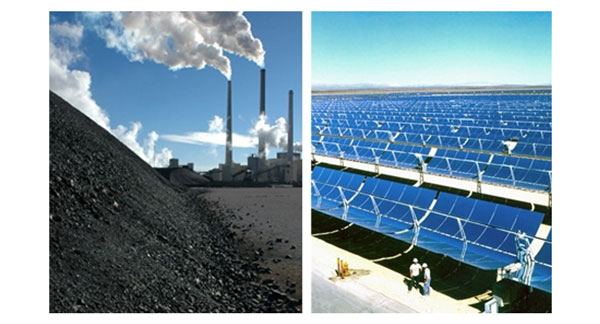Contents:
The global energy landscape is undergoing a significant transformation as countries strive to transition to cleaner and more sustainable energy sources. Among the numerous options, coal and solar energy stand out due to their contrasting characteristics. This article delves into the pros and cons of both energy sources, offering insights into which might be better suited for a sustainable future.

Overview of Coal and Solar Energy
Coal Energy:
Coal is a fossil fuel formed over millions of years from decomposed plant matter. It has been a dominant energy source for centuries, powering industries and homes alike.
Solar Energy:
Solar energy harnesses the sun's power using photovoltaic (PV) panels or solar thermal systems. It is a renewable and abundant source of energy that is gaining popularity globally.
Comparison of Coal and Solar Energy
Below is a detailed comparison of coal and solar energy in terms of cost, environmental impact, reliability, and scalability:
| Criteria |
Coal Energy |
Solar Energy |
| Cost |
Relatively low operational costs but high environmental and health costs. |
Higher initial installation costs but lower long-term costs due to free sunlight. |
| Environmental Impact |
Significant greenhouse gas emissions, air, and water pollution. |
Minimal environmental footprint with no direct emissions. |
| Reliability |
Reliable as it is not weather-dependent. |
Intermittent, requiring battery storage or grid connection for continuous supply. |
| Scalability |
Difficult to scale due to resource limitations and infrastructure constraints. |
Highly scalable with advancements in solar technology. |
Key Considerations
Economic Factors:
Coal is cheaper to produce in the short term but incurs long-term environmental and health costs. Solar energy, despite its high upfront cost, proves economical over its lifespan due to negligible operating expenses.
Energy Transition:
Global emphasis on decarbonization makes solar energy an attractive choice. Governments and organizations worldwide are adopting solar to meet net-zero carbon goals.
Technological Advancements:
Solar energy benefits from continuous innovation, such as improved efficiency in PV panels and enhanced energy storage solutions, making it increasingly competitive against coal.
Sustainability:
Coal, being finite, faces inevitable depletion, while solar energy’s renewability makes it a sustainable solution for future generations.
Global Trends in Energy Adoption
As nations move towards cleaner energy, the adoption of solar power has grown significantly. Conversely, coal usage is declining due to environmental regulations and rising public awareness. Below is a representation of global energy consumption trends for coal and solar energy over the last decade:
Challenges and Opportunities
Challenges of Coal Energy:
Coal mining is hazardous, and combustion releases significant amounts of carbon dioxide and pollutants into the atmosphere. Coal plants require expensive scrubbing technologies to mitigate emissions, adding to operational costs.
Challenges of Solar Energy:
Solar energy's intermittency demands robust energy storage systems. Additionally, solar panel manufacturing involves materials like silicon, the extraction of which has its own environmental impact.
Opportunities for Solar Energy:
-
Technological Innovations:
Ongoing advancements in photovoltaic cells and battery technology enhance energy efficiency and storage capabilities.
-
Government Incentives:
Many countries offer tax credits, subsidies, and grants to encourage solar adoption, making it more accessible to businesses and households.
-
Global Collaboration:
International efforts, such as the Paris Agreement, provide a platform for cooperation to scale renewable energy solutions.
Environmental Impacts: A Closer Look
The environmental impacts of coal and solar energy highlight the importance of transitioning to cleaner energy sources. The following table compares their impacts on key environmental metrics:
| Metric |
Coal Energy |
Solar Energy |
| Greenhouse Gas Emissions |
High CO₂ and methane emissions contribute significantly to climate change. |
No direct emissions during operation. |
| Land Use |
Large-scale mining disrupts ecosystems and landscapes. |
Requires substantial land for large solar farms but minimal disruption to ecosystems. |
| Water Usage |
Coal plants consume large amounts of water for cooling and ash disposal. |
Minimal water usage, primarily during panel cleaning. |
| Waste Generation |
Produces hazardous ash and slag that require safe disposal. |
End-of-life panels require recycling infrastructure. |
Economic Implications for Developing Nations
For developing nations, the choice between coal and solar energy often boils down to cost and accessibility. Coal plants are typically more affordable to construct in the short term, but their long-term environmental and health costs are significantly higher. Solar energy, while expensive upfront, offers long-term economic benefits due to reduced operating costs and government incentives.
Social Impacts of Energy Choices
Coal Energy:
-
Health Risks: Prolonged exposure to coal-related pollution increases respiratory illnesses and other health issues in surrounding communities.
-
Employment: Coal mining provides jobs, but many are high-risk and associated with poor working conditions.
Solar Energy:
-
Health Benefits: Eliminates harmful emissions, improving air quality and public health.
-
Job Creation: The solar sector creates opportunities in manufacturing, installation, and maintenance, contributing to sustainable employment.
Public Perception and Policy Influence
The perception of coal and solar energy varies across regions, heavily influenced by policies and education. Coal has historically been seen as a symbol of industrial strength, while solar energy represents innovation and environmental responsibility. Public awareness campaigns have increasingly highlighted the benefits of solar energy, driving shifts in consumer behavior and investment.
Policies also play a critical role. Subsidies for coal in some regions maintain its competitiveness, while renewable energy incentives, such as feed-in tariffs and tax breaks, encourage solar adoption. The balance of these policies can determine the trajectory of energy use in a region.
Role of Energy in Economic Growth
Energy is the backbone of economic development. For decades, coal-fired power plants have fueled industrial revolutions, urbanization, and economic growth. However, the environmental toll of this progress is now evident, with rising costs of climate adaptation and healthcare linked to pollution.
Solar energy offers a pathway to sustainable growth, reducing dependence on finite resources and minimizing environmental damage. Its decentralized nature also enables rural and off-grid communities to access electricity, fostering inclusive economic development.
Cultural and Regional Factors
In coal-dependent regions, transitioning to solar energy can be challenging due to cultural ties to coal industries and the social identity built around mining communities. Education and retraining programs are essential to help these communities adapt and thrive in a solar-powered economy.
On the other hand, in regions abundant with sunlight, solar energy aligns naturally with local conditions, becoming a culturally and economically viable solution. Governments and private enterprises are investing heavily in solar projects to leverage these natural advantages.
FAQs
Solar energy is more environmentally friendly because it does not produce greenhouse gases or air pollutants during operation. In contrast, coal combustion releases significant amounts of carbon dioxide, sulfur dioxide, and particulate matter, contributing to climate change and health issues.
Coal energy has lower initial setup costs but higher long-term environmental and health costs due to pollution. Solar energy requires a higher upfront investment for panels and installation but has minimal ongoing costs since sunlight is free, making it more economical in the long run.
Solar energy has the potential to replace coal, but it faces challenges like intermittency (dependency on sunlight). However, advancements in energy storage, such as batteries, and integration with smart grids can ensure a stable and reliable solar energy supply.
Coal remains widely used because of its historical infrastructure, cost-effectiveness for electricity generation in the short term, and its reliability as a non-weather-dependent energy source. Many regions also rely on coal due to existing investments and lack of access to renewable alternatives.
Government policies, such as subsidies for renewables, carbon taxes, and incentives for solar installations, are critical in accelerating the transition from coal to solar energy. These policies make solar energy more competitive and encourage investments in clean energy technologies.






